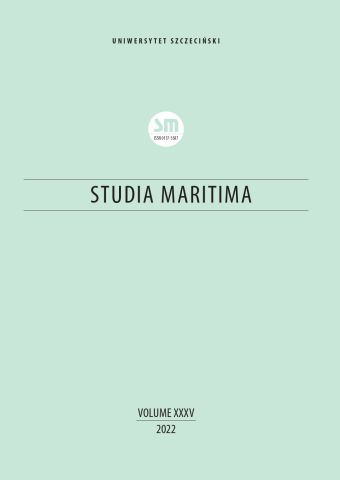






| Authors: |
Jarosław
Drozd

Institute of History University of Gdańsk |
| Keywords: | Jews Beitar Zionism Revisionism fascism maritime education |
| Data publikacji całości: | 2022 |
| Page range: | 21 (113-133) |
| 1. | Archival sources |
| 2. | Archiwum Państwowe w Gdańsku Oddział w Gdyni (sygn. APG OG 650/S–3301).– Komisariat Rządu w Gdyni, Kartoteka mieszkańców Gdyni 1926–1939 [State Archives in Gdańsk, Gdynia Branch (ref. no. APG OG 650/S–3301). Government’s Office in Gdynia. Files of Gdynia residents 1926–1939] |
| 3. | Printed sources |
| 4. | Arens, Moshe. In Defense of Israel. A Memoir of a Political Life, Washington, D.C.: Brookings Institution Press, 2018. https://doi.org/10.1080/23739770.2019.1598675 |
| 5. | Taniewski-Elliott, Wadim Konstanty. Spis personelu zatrudnionego na statkach Polskiej Marynarki Handlowej w latach 1939–1945 [List of personnel employed on the ships of the Polish Merchant Navy], Gdańsk: Towarzystwo Przyjaciół Centralnego Muzeum Morskiego, 1981. |
| 6. | Newspapers and magazines |
| 7. | 5 ta Rano (1938) Chad-ness (1937) |
| 8. | Chwila (1935–1936) |
| 9. | Das Jüdische Volk (1937) |
| 10. | Die Neue Welt (1935–1937) |
| 11. | Haneszer (1935) |
| 12. | Israel. Hebdomadaire Juif Indépendant (1935) |
| 13. | Israelitisches Familienblatt (1937) |
| 14. | Jewish Daily Bulletin (1935) |
| 15. | Judisk Krönika (1936) |
| 16. | Jüdische Wochenspost (1935) |
| 17. | Jüdisches Gemeindeblatt für den Verband der Kultusgemeinden in Bayern (1937) |
| 18. | Jüdisches Volksblatt (1935) |
| 19. | L`Aurore (1937) |
| 20. | Nasz Przegląd (1937) |
| 21. | Nowy Dziennik (1935) |
| 22. | The Sentinel (1935–1939) |
| 23. | Trybuna Narodowa (1935–1938) |
| 24. | References |
| 25. | Bell, J. Bowyer. Terror out of Zion: Irgun Zvai Leumi, LEHI, and the Palestine Underground 1929–1949. New York: Avon Books, 1977. https://doi.org/10.2307/2536327 |
| 26. | Bettin, Cristina M. Italian Jews from Emancipation to the Racial Laws. New York: Palgrave MacMillan, 2010. https://doi.org/10.1080/13532944.2012.754980 |
| 27. | Drozd, Jarosław. “Kursy portowe i rybackie dla Żydów w Gdyni w okresie Międzywojennym.” Nautologia 142 (2005): 37–41. |
| 28. | Drozd, Jarosław. Lost in the Whirlwind of War: The Jewish Community in Gdynia, Poland. Gdynia: Oficyna Verbi Causa, 2008. |
| 29. | Drozd Jarosław. “Gdynia to Neve-Yam: The Jewish fisherman`s courses within the Bays of Gdańsk and Puck in the interwar period.” Studia Maritima 26 (2013): 55–68. |
| 30. | Drozd, Jarosław. “Idea palestyńskiego morza. Działalność Związku Zebulun w latach 30-tych XX wieku.” Nautologia 158 (2021): 24–32. |
| 31. | Heller, Joseph. The Stern Gang. Ideology, Politics and Terror, 1940–1949. London-New York: Routledge Taylor & Francis Group, 2004. https://doi.org/10.4324/9780203043868 |
| 32. | Kaplan, Eran. The Jewish Radical Right: Revisionist Zionism and Its Ideological Legacy. Madison: University of Wisconsin Press, 2005. |
| 33. | Pizutti, Marco. Biografia non autorizzata della Seconda Guerra Mondiale. Milano: Mondadori, 2018. |
| 34. | Salerno, Eric. Mossad base Italia. Le azioni intrighi, le verita nascoste. Milano: Il Saggiatore S.P.A., 2010. |
| 35. | Shindler, Colin. The Triumph of Military Zionism. Nationalism and the Origins of the Israeli Rights. London: I.B.Tauris & Co Ltd., 2005. https://doi.org/10.5040/9780755609383 |
| 36. | Shindler, Colin. The Hebrew Republic. Israel’s Return to History. Lanham-Boulder-New York-London: Rowman & Littlefield, 2017. |
| 37. | Tamir, Dan. Hebrew Fascism in Palestine 1922–1942. Cham: Palgrave Macmillan, 2018. https://doi.org/10.1007/978-3-319-73679-2 |